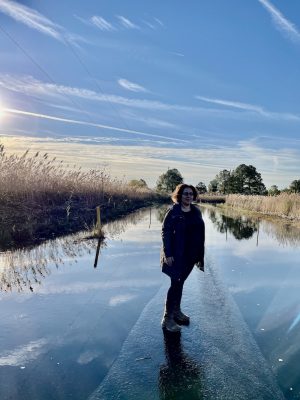Being Jewish
Commentary
My Jewish Connection to a Black Church Community

It’s Sunday morning and I’m in church again, greeting the regulars and bear-hugging the pastor. Miss Marleen asks after my children. Mr. John wants to know about my health. Miss Claudia says she’ll add me to the prayer list when I tell her I may need surgery for nagging abdominal pain.
Martin Luther King Jr. famously said: “Church is still the most segregated major institution in America. At 11:00 on Sunday morning when we stand and sing and Christ has no east or west, we stand at the most segregated hour in this nation,” with Black worshipers and white ones self-separating.
But for the past year, I’ve been crossing that barrier, attending services on and off at Macedonia United Methodist Church, a Black congregation on Deal Island, a flood-prone peninsula on Maryland’s Lower Eastern Shore. I’ve sat in on the worship there more often than at my own synagogue in Baltimore. I come because I am documenting a place that is slipping away.
Sea levels on the Eastern Shore are expected to rise three feet by the year 2100, according to University of Maryland scientists. Already, saltwater is intruding and creating ghost forests of spindly trees where healthy loblolly pines once stood. In Macedonia’s church graveyard, coffins have popped up from the ground, the force of the water too great to hold the dearly departed in place.

Most of the Black residents who called this place home have left, their land too wet and their flooded homes too costly to repair. Government aid often won’t cover repairs in flood zones, so the land became abandoned. Only two of Macedonia’s original Black families remain, and both have grappled with flooding.
Yet, the church’s pews fill every Sunday with worshipers who once lived there. They are holding on to the last pieces of their history.
I come from a place that slipped away, too. My mother’s family hailed from Bardejov, Slovakia, which had a thriving Jewish community before the Nazis invaded in 1942. My father’s family came from Ukraine. Today, there are no Jews in Bardejov. If I were to return there, or to Ukraine—as impossible as that is now—there would be few signs of my ancestors’ existence, let alone anyone able to share stories of them.
Telling the story of places that are lost, or about to be lost, has become a large part of my job as an environmental journalist. It’s not enough to announce that the planet is warming, that waters are rising and that treasured lands will be underwater within our lifetimes. I must also share the stories of the people who lived in those places.
I wrote my master’s thesis about Macedonia’s Black community and how the value of their property continues to erode. Climate change, government neglect, an inability to incorporate as a township and thereby exert authority over the area as well as state land-use policies have merged into a rural redlining of sorts that has robbed residents of opportunities for generational wealth.

Riley Roberts Road.
Many families, including mine, borrow against their homes’ value to pay for college or to give their children a down payment for a home of their own. Some pass down the property, providing a place to live during the early years of building careers. That’s not possible when rising waters diminish a property’s value. Climate change disproportionately affects the ability to pass on stability.
Along with two colleagues, I am making a film, Eroding History, about the Black community on the Eastern Shore. I have spent countless hours in the graveyard at Macedonia, thick with mosquitoes and greenhead flies. There, I have been able to trace the roots of the first Black families that settled on Riley Roberts Road, the soggy gravel path winding through Macedonia.
The Wigfalls, Wallaces, Roberts and Jones families, among others, came to these lowlands to live as free people after Emancipation. Later, they encouraged their children to leave for better opportunities in nearby Salisbury and Baltimore, Md., as well as Wilmington, Del., and Philadelphia.
One native who left, Lorraine Wigfall Henry, owned a whole block of real estate in Philadelphia. She returned in 1952 to establish a resort, Henry’s Beach, that welcomed Negro leagues baseball players as well as singers James Brown and Percy Sledge. It closed in 1982. On the other end of the peninsula, a fisherman’s daughter named Emma Berdis Jones set out for a new life in Harlem. Her son was the legendary writer James Baldwin.
While I know that we cannot save every place, I want to shine a light on the inequities embedded in the decisions of what gets saved. At the same time, we are trying to connect the community with historic preservation experts and engineers who can help bring in resources and save some of these important pieces of Black history—our country’s history, really—before it is too late.
In Deuteronomy 16:20, God admonishes the Israelites to appoint fair judges: “Justice, and only justice, you shall follow, that you may live and inherit the land that the Lord your God is giving you.”
The Jews of Europe lost their land—and many, their lives—and they could do nothing about it. On the Eastern Shore, the loss is more of a slow erosion than an annihilation. And we can do something about it.
Rona Kobell is a longtime environmental journalist and professor. She recently co-founded the Environmental Justice Journalism Initiative to help communities tell their own stories.










 Facebook
Facebook Instagram
Instagram Twitter
Twitter
Barbara Shapiro says
This is terrific! Thank you! I can’t wait to meet you! I have forwarded this the Rachel Monroe, of the Weinberg Foundation and to Rabbi Dana Saroken of Beth El Synagogue,